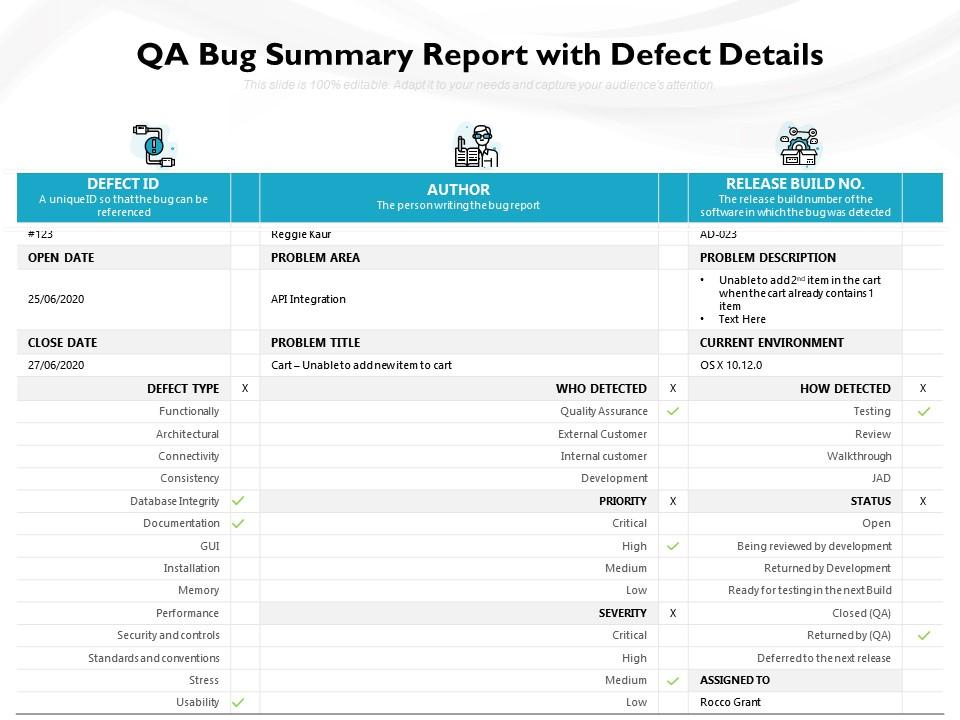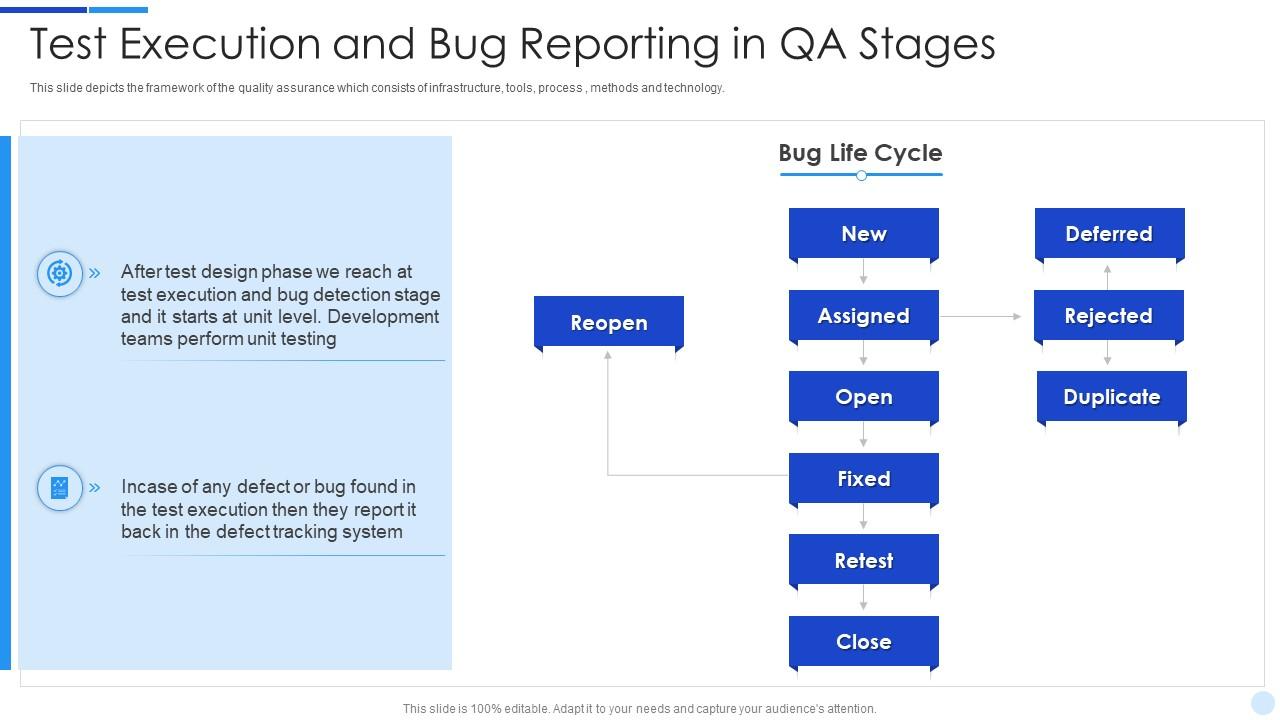QA (Quality Assurance) testing is tough.
That’s why it is crucial to choose the right bug-reporting process.
Are you familiar with the phrase "work smarter, not harder"? This is, after all, what our bug report templates are for.
This philosophy is implemented on a daily basis (and in the work of your reliable QA team) to increase productivity, boost precision, and make your life a whole lot simpler.
Your QA team can work more effectively without sacrificing the thorough documentation if you use the tools that provide the choice of visual communication. This has the inherent advantage of conserving your firm’s resources and improving financial results.
Here is a preview of SlideTeam’s bug report templates. Deploy these professionally created slides that are 100% customizable and content-ready to assist you in delivering accurate bug reports to the management and give new shape to your projects and businesses!
Template 1: QA Bug Summary Report With Defect Details
Quality analysis is critical to software testing. Each software functionality is tested in a myriad ways to check if it meets performance expectations. This strategically created PPT Template displays the summary report where each bug is documented. The defect details are mentioned, including the defect ID, assignee, author, release, label, tag, and so on.
The slide also delineates a book summary report that can be used for quality assurance testing and tracking defects recorded in multiple releases. For professional ease and convenience, the layout is divided into three sections, the defect ID, the author or person who locks the defect, and the release or build number in which the bug is detected.
It contains the bug's open/issuance and closing date, along with detailed information about the defect type, like functionality, architecture, consistency, database integrity, GUI, performance, and so on. In the middle section, space is provided where the entire problem or defect description can be written down. There are multiple options as to the person who detected the bug, the priority level of the defect, and its severity, which will help you to present a detailed and professional report.
Information about the current environment information and its status is documented in the third column, making it easier to track the defect and progress on resolving it.
The table can be customized according to the suitability of your project, from the author's name to the severity of the bug and the priority options to dig that a business may choose. This PPT Slide is available in two aspect ratios of 4:3 and 16:9 to accommodate multiple device screens. Being an Agile PPT Slide, it allows users to add charts, images, tables, and icons to ensure the information is understandable and always easy to relate to.
The slide will help increase the overall team productivity and maximize revenues to the business because using it is actually adding a tool for productivity to your business arsenal. Quickly download this slide and leave a long-lasting impression on the stakeholders, team leaders, project managers, leaders, and so on.
TEMPLATE 2: Quality Assurance Processes In Test Execution And Bug Reporting PPT Slides Rules
Quality assurance is certainly a tedious process, but it has to be done if the product is to see timely market release and propel the business forward.
Testing is necessary to check the quality of the functions, features, and other verticals before the final release. Are you seeking a professional template to do this for you while you use your valuable time in the growth of your business? You have landed in the appropriate place!
This PPT Slide allows users to define the quality assurance testing process and list the specific rule set for each process or stage. Once circulated among employees handling this business function, it will bring more productivity to the project and greater efficiency in employee performance. This informative slide documents all stages required to plan the quality assurance test appropriately.
The stages are described in a flow chart fashion to help your audiences understand these in chronological order; the aim is to comprehend what the bug life cycle should be. The flowchart components and arrow directions can be customized according to your project's convenience and the acceptable bug status. Multiple editable icons are available in each topic to make the slide more presentable and visually appealing.
Define every step in detail on the right-hand side and mark each stage with a different icon for easier identification and reference. Download this right away and dazzle your audience!
Never Let The Same Bug Bite You More Than Once: Wrapping Up!
As you can see, there are a variety of ready-to-use bug report templates that can assist your QA team’s work in being more effective and maintain open lines of communication with your development team.
A clear, well-detailed, and professional report on bugs will always make it simpler for your developer to see the issue, which enables them to correct it right away. Your bug reporting system will then be more efficient, thorough, and systematic when defining, documenting, and identifying the bugs.
It also helps engineers determine how long the solution might take. The more data that is available to developers, the faster a remedy can be designed and put into place. Work more efficiently by using a ready-to-use bug report template created by SlideTeam professionally with our motto to assist businesses!
FAQs on Bug Reports
How do you write a bug report example?
A thorough bug report contains details about the defect that can be used in the debugging procedure. The following information should be included in a good bug report:
- Subject/Defect ID: The bug should be briefly described in the title.
- Environment: A defect could show up in one setting but not another.
- How to replicate a bug: The stages should be numbered from beginning to end so that the engineers can follow these to verify the bug.
- Expected Outcome: This section of the bug report explains how the program should behave in the scenario that has been provided.
- Actual Outcome: Describe the actual behavior of the defect and how it deviates from the desired outcome.
- Visual evidence of the bug: It is necessary to submit screenshots, recordings, and log files to show how the bug manifests itself.
- The intensity and the priority level: Every bug needs to have a severity rating and associated priority assigned to it.
What should a bug report contain?
Filing a bug report is essential in the bug life cycle, which follows its identification. This phase establishes the groundwork for debugging and guarantees a flawless user experience. Good bug reports are clear about what has to be corrected and speed up development.
It helps avoid delays in software releases and provides a quicker time-to-market without sacrificing quality. The first and most important step is finding the bug, and the crucial testing aspect is recording the discovered software flaws. A specific bug or defect report can significantly speed up finding and fixing the issues. The typical components of a bug report comprise the following:
- Quick recap
- Explanation
- Intensity
- Primary concern
- Time and date
- Application Under Test Version and Release Build Number
- Recorded by
- Related necessity
- Attachments/Proof
What is a bug in QA testing?
Test execution and confirming that a software application or product is carrying out its intended function is known as quality assurance (QA). In quality assurance, a bug is a flaw or mistake in software, system, or component that can prevent those elements from carrying out their intended functions. In other words, if a flaw or defect is discovered during the test execution, it may result in the breakdown of components, which means they will not function as planned. Wrong data definitions, expressions, input data, layout, etc., are a few examples. A bug-ridden program will display functional (usefulness) and non-functional (privacy, efficiency, etc.) problem areas that must be fixed before your users give up or run into a severe problem that could endanger the good name and financial health of your company.
What is a QA bug report?
When a bug is found during the QA stages, it must be documented and reported to the developers for correction. Most QA workflows produce many bugs because software is deep, complicated, and feature-rich in the digital environment. Additionally, developers work on many development projects at once, impacting quality. . They are under a lot of pressure and risk being overwhelmed if they don’t have the correct tools. Naturally, QAs invest in learning how to report bugs in a way that assists developers and enables them to debug quickly and effectively. One of these resources is well-organized, adequately detailed bug reports. Excellent bug reports show what needs to be fixed and hasten development. They prevent software releases from being delayed and lead to speedier time-to-market without compromising quality.





 Customer Reviews
Customer Reviews






















